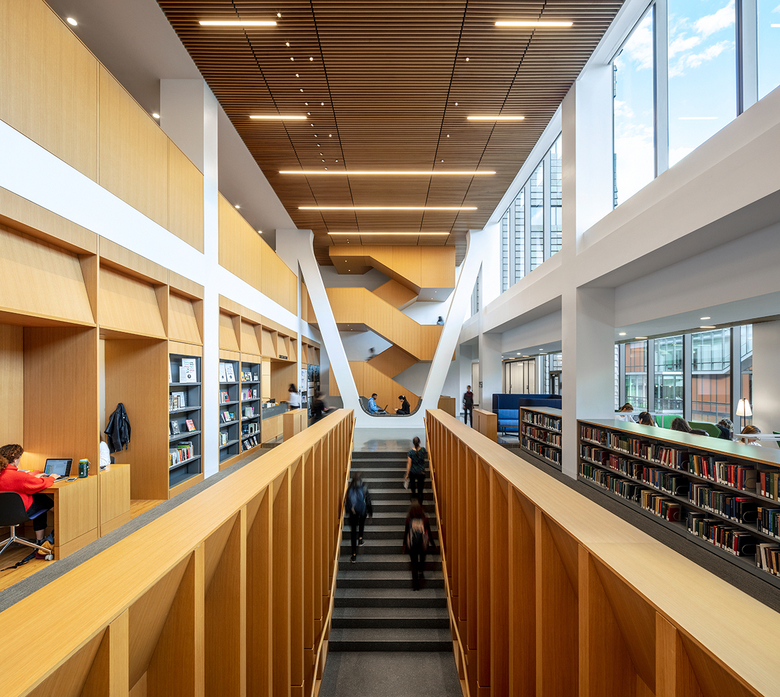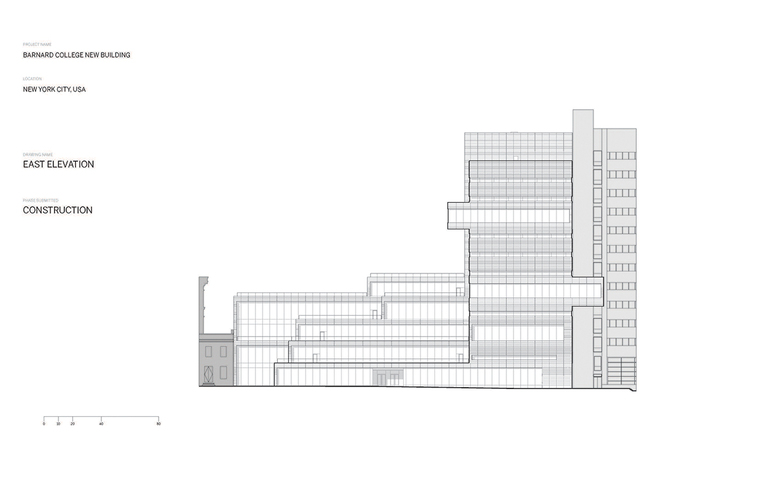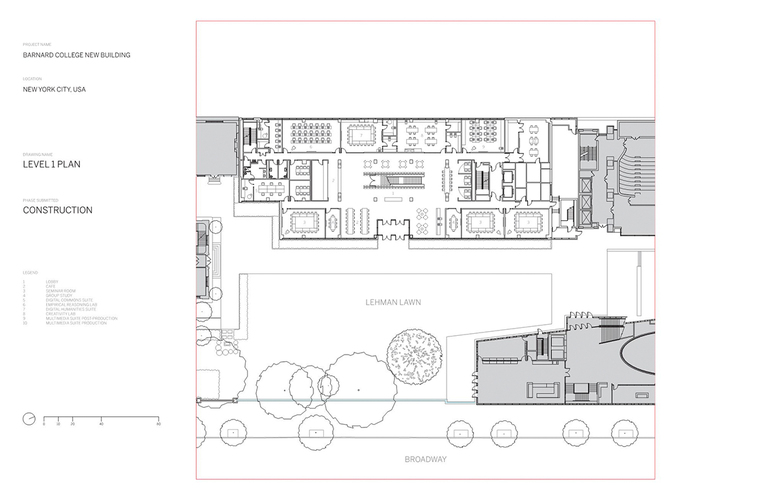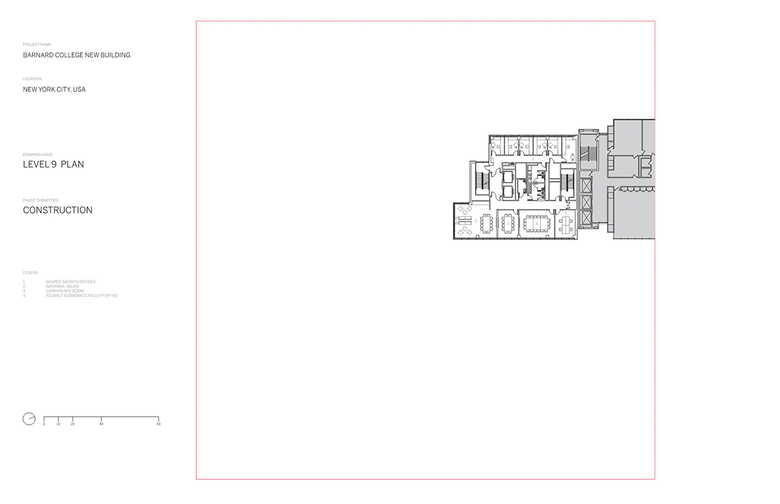U.S. Building of the Week
The Milstein Center
Skidmore, Owings & Merrill
18. février 2019
Photo: Magda Biernat, courtesy of SOM
Barnard College occupies a small four-acre campus in New York's Morningside Heghts neighborhood, meaning expansion this century has involved the demolition of smaller modern buildings and their replacement with taller buildings. Down came Lehman Hall and up went the Milstein Center, which houses Barnard's library and numerous other functions. Skidmore, Owings & Merrill answered a few questions about the project.
Location: New York, NY, USA
Client: Barnard College
Architect: Skidmore, Owings & Merrill LLP
Senior Consulting Design Partner: Roger Duffy, FAIA
Managing Partner: T.J. Gottesdiener, FAIA
Design Partner: Colin Koop, AIA
Project Manager: Meredith Bostwick-Lorenzo Eiroa, AIA
Project Team: Carrie Moore, AIA; Kimberly Garcia, AIA; Jon Cicconi, AIA; Lulu Li, AIA; Julia Grabazs; Leonard Lopate, AIA; Michi Ushio, AIA; Christoph Timm, AIA; Cynthia Mirbach
Owner’s Representative: Lehrer, LLC
Construction Manager: Turner Construction
Programming Consultant: Brightspot Strategy
Cost Estimating: Aecom
Landscape Architect: Quennell Rothschild & Partners
Structural Engineering: Robert Silman Associates
Site/Civil Engineering: Langan Engineering
MEP/FP Engineering: WSP Group
Lighting Design: Brandston Partnership, Inc.
Acoustics, AV, IT & Security: Cerami & Associates
Sustainable Design Code Consulting: SOM Sustainable Engineering Studio
Photo: Magda Biernat, courtesy of SOM
What were the circumstances of receiving the commission for this project?Barnard College approached SOM to design a campus-wide nexus of teaching and scholarship. Rather than serving one exclusive discipline or purpose, the building had to celebrate Barnard’s interlocked endeavors as a place of study, collaboration, interaction, and multidisciplinary problem solving. The selection process was complex, encompassing qualification and proposal stages, two interviews, and a site tour of one of SOM’s completed higher education buildings in Manhattan.
Photo: Magda Biernat, courtesy of SOM
Please provide an overview of the project.The Cheryl and Philip Milstein Center for Teaching and Learning was designed as a place of interdisciplinary scholarship – it is the new hub of academic and intellectual life on Barnard College’s campus. Its program of diversified yet synergistic resources culminate in a new kind of library. The library celebrates Barnard’s collection by expanding its archival storage, while emphasizing the integration of state-of-the-art technology in its programming. It connects with a range of teaching labs and flexible learning spaces, including centers for pedagogy, empirical reasoning, digital humanities, design, and media, as well as a movement lab. The building also houses the Vagelos Computational Science Center, faculty offices, and interdisciplinary workspaces for four academic departments, as well as the Athena Center for Leadership Studies and the Barnard Center for Research on Women. Through the integration of these elements, this building is a multimodal place that supports the college’s interdisciplinary curriculum through studying, creating, sharing, researching, and synthesizing all forms of knowledge and data.
Photo: Magda Biernat, courtesy of SOM
What are the main ideas and inspirations influencing the design of the building?The Milstein Center plays a central role in fulfilling Barnard College’s mission: providing another 125 years of service to women of intellect, ambition, and vision. The Milstein Center houses the Barnard Center for Research on Women and the Athena Center for Leadership Studies, celebrating Barnard’s commitment to women-led research and impact on the world. The library was also designed to exemplify the culture of intellectual collaboration and interdisciplinary interchange that defines Barnard College – creating a space that facilitates cross-departmental ties, stimulates global connections, and fosters bonds between students and faculty.
Photo: Magda Biernat, courtesy of SOM
Barnard’s new Foundations curriculum played a key role in The Milstein Center’s design. Foundations brings together each area of study into an educational experience that leverages 21st-century tools and technology. The Milstein Center intentionally integrates the arts, humanities, natural sciences, and social sciences while aiming to transcend former notions of what a “library” means – embracing technology by providing state-of-the-art learning spaces with interactive settings, digital media, and virtual learning tools with the flexibility to serve various disciplines and group sizes. Therefore, The Milstein Center is positioned as a central building on campus that visually, experientially, and physically embodies the Foundations curriculum.
Photo: Magda Biernat, courtesy of SOM
How does the design respond to the unique qualities of the site?The Milstein Center is designed in response to its prominent location overlooking the Lawn, an iconic and frequently used public space on campus. The building’s massing, with a narrow, 11-story tower and five-story base that rises in a series of terraces, opens the Lawn to the sun, carries the ground-level green space onto the library floors, and provides a series of inviting outdoor spaces within the urban campus. The tower aligns with and connects to Altschul Hall through a skybridge on the fifth floor, and the lower level provides a continuous subgrade link from the library to other campus assets in Barnard Hall, Altschul Hall, and the Diana Center. Materials selections are also sensitive to the surrounding atmosphere: the building's facade is patinated with zinc panels to match surrounding stone, brick, and concrete buildings, achieving a look that is both contemporary and harmonious with the rest of the campus. Near the top of The Milstein Center, a cantilevered volume contains a faculty lounge with sweeping views of the Hudson River, Columbia University’s campus, and Midtown Manhattan.
Photo: Magda Biernat, courtesy of SOM
Our design also took into consideration The Milstein Center’s relationship to the surrounding neighborhood – we met with campus and local community liaisons at key milestones in the design process to assess the building’s impact on the surrounding area, looking for opportunities to enliven the streetscape and proactively mitigate negative externalities like light pollution and noise. Because the library would be open in the evening, the community-facing building exterior was designed to minimize the apertures for daylight and was fixed with appropriate window shading systems.
Photo: Magda Biernat, courtesy of SOM
Was the project influenced by any trends in energy-conservation, construction, or design?During the design phase, SOM worked collaboratively with the construction manager to develop an integrated design-assist process with an exterior wall fabricator. Through this process, a series of early shop drawing review charrettes enabled the early purchase of the exterior wall to eliminate over one year of escalation cost.
SOM also led an integrative user engagement process from day one. The project’s governance, or “Steering Committee”, was composed of a broad cross-section of campus representatives – including College leadership, donors, heads of all faculty departments, library staff, and students. The committee met biweekly with the SOM project team during every phase to evaluate and guide the design’s progress, hosting focus groups and listening sessions along the way. The Steering Committee collaboratively built the “must have” programs and vetted the “wish list” programs, helping us build consensus at those times when aligning the project scope to the project’s budget was necessary. Focus groups pulled together faculty with diverse and like-minded interests to define the objectives, goals, and functional parameters for the library, the Computational Science Center, and the Digital Commons.
Sustainability was at the forefront of our design, supporting both Barnard’s environmental curriculum and the College’s vision to build a more sustainable campus and reduce carbon emissions. The Milstein Center is targeting LEED v3 Silver Certification, and is designed to achieve 15 percent energy cost savings compared to ASHRAE 90.1 2007, 33 percent water savings within the building, 50 percent water savings for landscape irrigation, and 90 percent construction waste diversion.
Photo: Magda Biernat, courtesy of SOM
What products or materials have contributed to the success of the completed building?The baroque zinc exterior wall, with its soft reflectivity and warmth, contextualizes the project in its campus setting and harmonizes with surrounding brick, stone, and concrete buildings. At the same time, the metal facade expresses a contemporary aesthetic that distinguishes The Milstein Center as a building of its time. The main teaching and learning areas along the street front are also opened with glazing to activate the spaces and to allow views inside. The choice of wood for the ceilings signifies the public sequence, and creates a warm environment for learning spaces. Careful lighting design throughout the building combines natural light, programmed lighting scenes, and individual controls to enhance learning environments while contributing to energy savings.
Email interview conducted by John Hill.



















